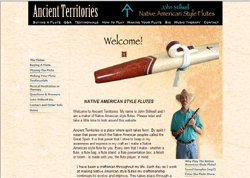Playing the Native American Flute: Lesson Three
Playing the Native American Flute: Lesson Three
If you have gone through the first two lessons and have experienced the thrill of hearing real musical sounds come from your flute you will be more than ready to develop some new skills. In this lesson I will show you how to add variety and dynamics to your playing.
First, make the sound tah by touching the tip of your tongue to the top of the pallet of your mouth and blowing some air pressure against it as you suddenly let the tongue go slack. It’s a tah like the beginning of the word table. Do you feel the air blow outward explosively? Try it again – make the sound tah, tah, tah out loud. Now, do it again silently. Put your flute to your mouth and with all holes closed. Make a silent tah into the flute as you sound the fundamental note. Now sound the fundamental by just blowing into the flute. Do you hear the difference between these two sounds? The one made with a tah is sharper and quicker than the plain blowing into the flute. This is called a different articulation of the note.
You have learned how to go up the scale by blowing into the flute as you sound each succeeding note. Now, go up the scale but make a silent tah each time you sound a new note. Remember the force of the breath comes from the solar plexus. One, two, three, four, five, six tah notes. Then, go back down the scale with the same articulation. Let’s change it a little by doing a double tah with each note as you go up and down the scale of your Native American flute. You sound the note twice - tah, tah note one, note two, etc. And, back down the scale again.
Try the same double note with the breath only as you did with the first exercise. Isn’t it interesting how a simple change in the way the note is articulated could make such a difference? Now, alternate the two different ways of sounding notes as you go up the scale. Start by sounding the fundamental note with a tah articulation and then sound the second note with a simple breath articulation. Continue up and then down the scale using the two different ways of sounding the note alternatively. Play with this for a while. Use some tah notes and blowing note in random combinations and listen to what you are creating. You are adding variety to the sounds the flute is making.
Remember in lesson two when you held notes for different periods of time. Some long some short. Now play with elongating and shortening the length of time a note is held and the way the note is articulated. Let your fingers and breath play with the possibilities for a while. Throw in some short intervals of silence between some of the notes. The silent interval is called a rest. Hear how the notes start to find relationships between each other? Your playing is starting to become dynamic.
After this lesson you are equipped to really play with your flute. If you would like more information about playing and making flutes you may go to my website at <a href=http://atflutes.com/>http://atflutes.com/</a> for more information. Enjoy!

